Heating Impact of a Tropical Reservoir on Downstream Water Temperature: A Case Study of the Jinghong Dam on the Lancang River
Abstract
:1. Introduction
2. Study Area
2.1. Observation Data
2.2. Observation Data Analysis
2.2.1. Comparison with Historical Water Temperature
2.2.2. Discharge and Water Temperature
3. Methods
3.1. The Delft3D-FLOW Model
3.2. Model Set-Up
3.2.1. Grid Coverage
3.2.2. Boundary Conditions
3.2.3. Meteorological Data and Model Flow Chart
3.3. Model Calibration and Validation
3.4. Numerical Scenario Setups
4. Results and Discussion
4.1. Thermal Structure of the Jinghong Reservoir
4.2. Impact of Solar Radiation and Air Temperature
4.3. Impact of Outflow Rates
4.4. Impact of the Impoundment
5. Research Limitations
6. Conclusions
Author Contributions
Funding
Acknowledgments
Conflicts of Interest
References
- Carron, J.C.; Rajaram, H. Impact of variable reservoir releases on management of downstream water temperatures. Water Resour. Res. 2001, 37, 1733–1744. [Google Scholar] [CrossRef]
- Olden, J.D.; Naiman, R.J. Incorporating thermal regimes into environmental flows assessments: Modifying dam operations to restore freshwater ecosystem integrity. Freshw. Biol. 2010, 55, 86–107. [Google Scholar] [CrossRef]
- Rheinheimer, D.E.; Null, S.E.; Lund, J.R. Optimizing selective withdrawal from reservoirs to manage downstream temperatures with climate warming. J. Water Resour. Plan. Manag. 2015, 141, 04014063. [Google Scholar] [CrossRef]
- Hynes, H.B.N. Lotic biology. (Book reviews: The ecology of running waters). Science 1971, 172, 251. [Google Scholar]
- Sullivan, K.; Martin, D.J.; Cardwell, R.D.; Inc, P.; Toll, J.E.; Inc, P.; Duke, S. An analysis of the effects of temperature on salmonids of the pacific northwest with implications for selecting temperature criteria. Sustainable ecosystems institute. Histochemistry 2000, 90, 85–97. [Google Scholar]
- Poole, G.C.; Berman, C.H. An ecological perspective on in-stream temperature: Natural heat dynamics and mechanisms of human-caused thermal degradation. Environ. Manag. 2001, 27, 787–802. [Google Scholar] [CrossRef]
- Lessard, J.A.L.; Hayes, D.B. Effects of elevated water temperature on fish and macroinvertebrate communities below small dams. River Res. Appl. 2010, 19, 721–732. [Google Scholar] [CrossRef]
- Murchie, K.J.; Hair, K.P.E.; Pullen, C.E.; Redpath, T.D.; Stephens, H.R.; Cooke, S.J. Fish response to modified flow regimes in regulated rivers: Research methods, effects and opportunities. River Res. Appl. 2008, 24, 197–217. [Google Scholar] [CrossRef]
- Ward, J.V. Thermal characteristics of running waters. Hydrobiologia 1985, 125, 31–46. [Google Scholar] [CrossRef]
- Brooker, M.P. The impact of impoundments on the downstream fisheries and general ecology of rivers. Adv. Appl. Boil. 1981, 6, 91–152. [Google Scholar]
- Horne, B.D.; Rutherford, E.S.; Wehrly, K.E. Simulating effects of hydro-dam alteration on thermal regime and wild steelhead recruitment in a stable-flow lake michigan tributary. River Res. Appl. 2004, 20, 185–203. [Google Scholar] [CrossRef]
- Krause, C.W.; Newcomb, T.J.; Orth, D.J. Thermal habitat assessment of alternative flow scenarios in a tailwater fishery. River Res. Appl. 2005, 21, 581–593. [Google Scholar] [CrossRef]
- Ryan, T.F.; Webb, J.A.; Lennie, R.; Lyon, J. Satus of Cold Water Releases from Victorian Dam; Dept. of Natural Resources and Environment: Heidelberg, Australia, 2001. [Google Scholar]
- Preece, R. Cold Water Pollution below Dams in New South Wales: A Desktop Assessment; Water management Division, Dept. of Infrastructure, Planning and Natural Resources: Sydney, Australia, 2004. [Google Scholar]
- Jackson, H.M.; Gibbins, C.N.; Soulsby, C. Role of discharge and temperature variation in determining invertebrate community structure in a regulated river. River Res. Appl. 2007, 23, 651–669. [Google Scholar] [CrossRef]
- Angilletta, M.J.; Steel, E.A.; Bartz, K.K.; Kingsolver, J.G.; Scheuerell, M.D.; Beckman, B.R.; Crozier, L.G. Big dams and salmon evolution: Changes in thermal regimes and their potential evolutionary consequences. Evol. Appl. 2008, 1, 286–299. [Google Scholar] [CrossRef] [PubMed]
- Campbell, I.C. The Mekong: Biophysical Environment of an International River Basin; Elsevier Academic Press: Amsterdam, The Netherlands, 2009. [Google Scholar]
- Zhao, A.G. Planning and development of lower and middle Lancang River’s water power resources. Pearl River 2000, 21, 5–8. [Google Scholar]
- Fan, H.; He, D.; Wang, H. Environmental consequences of damming the mainstream Lancang-Mekong River: A review. Earth-Sci. Rev. 2015, 146, 77–91. [Google Scholar] [CrossRef]
- Lu, X.X.; Siew, R.Y. Water discharge and sediment flux changes over the past decades in the lower Mekong River: Possible impacts of the Chinese dams. Hydrol. Earth Syst. Sci. 2006, 10, 181–195. [Google Scholar] [CrossRef]
- Campbell, I.C. Perceptions, data, and river management: Lessons from the Mekong River. Water Resour. Res. 2007, 43, 329–335. [Google Scholar] [CrossRef]
- Lu, X.X.; Li, S.; Kummu, M.; Padawangi, R.; Wang, J.J. Observed changes in the water flow at Chiang Saen in the lower Mekong: Impacts of Chinese dams? Quat. Int. 2014, 336, 145–157. [Google Scholar] [CrossRef]
- Haxton, T.J.; Findlay, C.S. Meta-analysis of the impacts of water management on aquatic communities. J. Can. Sci. Halieutiques Aquat. 2008, 65, 437–447. [Google Scholar] [CrossRef]
- Gao, X.; Zhang, S.; Zhang, C. 3-D numerical simulation of water temperature released from the multi-level intake of Nuozhadu hydropower station. J. Hydroelectr. Eng. 2012, 31, 195–201+207. [Google Scholar]
- Wurbs. Computer Models for Water Resources Planning and Management; S Army Corps of Engineers, Institute for Water Resources: Alexandria, VA, USA, 1994. [Google Scholar]
- Imteaz, M.A.; Asaeda, T.; Lockington, D.A. Modelling the effects of inflow parameters on lake water quality. Environ. Model. Assess. 2003, 8, 63–70. [Google Scholar] [CrossRef]
- Peeters, F.; Livingstone, D.M.; Goudsmit, G.; Kipfer, R.; Forster, R. Modeling 50 years of historical temperature profiles in a large central European lake. Limnol. Ocean. 2002, 47, 186–197. [Google Scholar] [CrossRef] [Green Version]
- Kraus, E.B.; Turner, J.S. A one-dimensional model of the seasonal thermocline II. The general theory and its consequences. Tellus 1967, 19, 98–106. [Google Scholar] [CrossRef]
- Imberger, J.; Patterson, J.; Hebbert, B.; Loh, I. Dynamics of reservoir of medium size. J. Hydraul. Div. 1978, 104, 725–743. [Google Scholar]
- Svensson, U. A Mathematical Model of the Seasonal Thermocline. Ph.D. Thesis, University of Lund, Lund, Sweden, 1978. [Google Scholar]
- Hostetler, S.W.; Bartlein, P.J. Simulation of lake evaporation with application to modeling lake level variations of Harney-Malheur Lake, oregon. Water Resour. Res. 1990, 26, 2603–2612. [Google Scholar]
- Hostetler, S.W.; Giorgi, F.; Bates, G.T.; Bartlein, P.J. Lake-atmosphere feedbacks associated with paleolakes Bonneville and Lahontan. Science 1994, 263, 665. [Google Scholar] [CrossRef] [PubMed]
- Zamboni, F.; Barbieri, A.; Polli, B.; Salvadè, G.; Simona, M. The dynamic model seemod applied to the Southern Basin of Lake Lugano. Aquat. Sci. 1992, 54, 367–380. [Google Scholar] [CrossRef]
- Karagounis, I.; Trösch, J.; Zamboni, F. A coupled physical-biochemical lake model for forecasting water quality. Aquat. Sci. 1993, 55, 87–102. [Google Scholar] [CrossRef]
- Ulrich, M. Modeling of Chemicals in Lakes-Development and Application of User-Friendly Simulation Software (MASAS & CHEMSEE) on Personal Computers. Ph.D. Thesis, Swiss Federal Institute of Technology, Zürich, Switzerland, 1991. [Google Scholar]
- Fang, X.; Stefan, H.G. Long-term lake water temperature and ice cover simulations/measurements. Cold Reg. Sci. Technol. 1996, 24, 289–304. [Google Scholar] [CrossRef]
- Burchard, H.; Bolding, K.; Villarreal, M.R. GOTM, a General Ocean Turbulence Model: Theory, Implementation and Test Cases; Space Applications Institute: Ispra, Italy, 1999. [Google Scholar]
- Goudsmit, G.H.; Burchard, H.; Peeters, F.; Wüest, A. Application of k-ϵ turbulence models to enclosed basins: The role of internal seiches. J. Geophys. Res. Ocean. 2002, 107, C12. [Google Scholar] [CrossRef]
- Stepanenko, V.M.; Lykossov, V.N. Numerical modeling of heat and moisture transfer processes in a system lake—Soil. Russ. J. Meteorol. Hydrol. 2005, 3, 95–104. [Google Scholar]
- Stepanenko, V.M.; Machul’Skaya, E.E.; Glagolev, M.V.; Lykossov, V.N. Numerical modeling of methane emissions from lakes in the permafrost zone. Izv. Atmos. Ocean. Phys. 2011, 47, 252–264. [Google Scholar] [CrossRef]
- Subin, Z.M.; Riley, W.J.; Mironov, D. An improved lake model for climate simulations: Model structure, evaluation, and sensitivity analyses in CESM1. J. Adv. Model. Earth Syst. 2012, 4, 1. [Google Scholar] [CrossRef]
- Gu, H.; Jin, J.; Wu, Y.; Ek, M.B.; Subin, Z.M. Calibration and validation of lake surface temperature simulations with the coupled WRF-lake model. Clim. Chang. 2015, 129, 471–483. [Google Scholar] [CrossRef]
- Karpik, S.R.; Raithby, G.D. Laterally averaged hydrodynamics model for reservoir predictions. J. Hydraul. Eng. 1990, 116, 783–798. [Google Scholar] [CrossRef]
- Brown, R.T. BETTER, A Two-Dimensional Reservoir Water Quality Model: Model User’s Guide; Tennessee Technological University: Cookeville, TN, USA, 1985. [Google Scholar]
- Waldrop, W.R.; Ungate, C.D.; Harper, W.L. Computer Simulation of Hydrodynamics and Temperatures of Tellico Reservoir; TVA Water Systems Development Branch: Norris, TN, USA, 1980. [Google Scholar]
- Edinger, J.E.; Buchak, E.M. Developments in LARM2: A Longitudinal-Vertical, Time-Varying Hydrodynamic Reservoir Model; US Army Engineer Waterways Experimental Station: Visburg, MS, USA, 1983. [Google Scholar]
- Buchak, E.M.; Edinger, J.E. Generalized Longitudinal-Vertical Hydrodynamics and Transport: Development, Programming and Application; US Army Engineer Waterways Experimental Station: Visburg, MS, USA, 1984. [Google Scholar]
- Cole, T.M.; Buchak, E.M. CE-QUAL-W2: A Two-Dimensional, Laterally Averaged, Hydrodynamic and Water Quality Model, Version 2.0. User Manual; US Army Engineer Waterways Experimental Station: Visburg, MS, USA, 1995. [Google Scholar]
- Chen, X.F.; Wang, G.X. Mike 21 software and its application on the offshore reconstruction engineering of Changxing Islands. J. Dalian Univ. 2007, 28, 93–98. (In Chinese) [Google Scholar]
- Wang, Z. Application of Mike 21 in ecological design of artificial lake. Water Res. Power 2008, 26, 124–127. (In Chinese) [Google Scholar]
- Cheng, Y.U.; Ren, X.; Ban, X.A.; Yun, D.U. Application of two-dimensional water quality model in the project of the water diversion in East Lake, Wuhan. J. Lake Sci. 2012, 24, 43–50. [Google Scholar] [CrossRef]
- Liang, Y.; Yin, J.; Zhu, X.; Huang, X. Application of Mike 21 hydrodynamic model in water level simulation of Hongze Lake. Water Res. Power 2013, 31, 135–137. [Google Scholar]
- Leendertse, J.J. Aspects of a Computational Model for Long-Period Water-Wave Propagation; Rand Corporation: Santa Monica, LA, USA, 1967. [Google Scholar]
- Kuipers, J.; Vreugdeuhil, C.B. Calculations of Two-Dimensional Horizontal Flow; Delft Hydraulics Laboratory Report: Delft, The Netherlands, 1973. [Google Scholar]
- McGuirk, J.J.; Rodi, W. A depth-averaged mathematical model for the near field of side discharges into open-channel flow. J. Fluid Mech. 1978, 86, 761–781. [Google Scholar] [CrossRef]
- Lauwerier, H.A. Some recent work of the Amsterdam Mathematical Centre on the hydrodynamics of the North Sea. Sticht. Math. Cent. Toegep. Wiskund. 1961, 1, 1–12. [Google Scholar]
- Isozaki, I.; Unoki, S. The numerical computation of the Tsunami in Tokyo Bay caused by the Chilean Earthquake in May 1960. In Studies on Oceanography—A Collection of Papers Dedicated to Koji Hidaka; Tokyo University Press: Tokyo, Japan, 1964. [Google Scholar]
- Ziegler, C.K.; Nisbet, B. Fine-Grained Sediment Transport in Pawtuxet River, Rhode Island. J. Hydraul. Eng. 1994, 120, 561–576. [Google Scholar] [CrossRef]
- Ziegler, C.K.; Nisbet, B.S. Long-Term Simulation of Fine-Grained Sediment Transport in Large Reservoir. J. Hydraul. Eng. 1995, 121, 773–781. [Google Scholar] [CrossRef]
- Chung, S.; Gu, R. Two-Dimensional Simulations of Contaminant Currents in Stratified Reservoir. J. Hydraul. Eng. 1998, 124, 704–711. [Google Scholar] [CrossRef]
- Tufford, D.L.; Mckellar, H.N. Spatial and temporal hydrodynamic and water quality modeling analysis of a large reservoir on the South Carolina (U.S.) coastal plain. Ecol. Model. 1999, 114, 137–173. [Google Scholar] [CrossRef]
- Ji, Z.G. Hydrodynamics and Water Quality: Modeling Rivers, Lakes, and Estuaries; John Wiley & Sons: Hoboken, NJ, USA, 2008. [Google Scholar]
- Sheng, Y.P. A Three-Dimensional Mathematical Model of Coastal, Estuarine and Lake Currents Using Bounary Fitted Grid; Report No. 585; Aeronautical Research Associates of Princeton: Princeton, NJ, USA, 1986. [Google Scholar]
- Blumberg, A.F.; Mellor, G.L. A description of a three-dimensional coastal ocean circulation model. In Three-Dimensional Coastal Ocean Models Coastal and Estuarine Sciences; American Geophysical Union: Washington, DC, USA, 1987. [Google Scholar]
- Hamrick, J.M. User’s Manual for the Environmental Fluid Dynamics Computer Code; College of William and Mary: Gloucester Point, VA, USA, 1996. [Google Scholar]
- Cerco, C.F.; Cole, T.M. Three-dimensional eutrophication model of Chesapeake Bay. Volume 1: Main report. Am. Soc. Civ. Eng. 1994, 119, 1006–1025. [Google Scholar] [CrossRef]
- Wool, T.A.; Ambrose, R.B.; Martin, J.L.; Cormer, E.A. Water Quality Analysis Simulation Program (WASP), Version 6.0; United States Environmental Protection Agency: Washington, DC, USA, 1995. [Google Scholar]
- Hydraulics. Delft3D-FLOW: Simulation of Multi-Dimensional Hydrodynamic Flows and Transport Phenomena, Including Sediments—User Manual; WL | Delft Hydraulics: Delft, The Netherlands, 2003. [Google Scholar]
- HydroQual. User’s Guide for RCA; Technical Report; HydroQual, Inc.: Mahwah, NJ, USA, 2004. [Google Scholar]
- Emma, J.; Lars-Göran, G.; Sten, B.; Tobias, L.; Jan-Olof, S.; Lillemor, C.L.; Destouni, G. Data evaluation and numerical modeling of hydrological interactions between active layer, lake and talik in a permafrost catchment, Western Greenland. J. Hydrol. 2015, 527, 688–703. [Google Scholar] [Green Version]
- Harcourt-Baldwin, J.L.; Diedericks, G.P.J. Numerical modelling and analysis of temperature controlled density currents in Tomales Bay, California. Estuar. Coast. Shelf Sci. 2006, 66, 417–428. [Google Scholar] [CrossRef]
- Maren, D.S.V. Grain size and sediment concentration effects on channel patterns of silt-laden rivers. Sediment. Geol. 2007, 202, 297–316. [Google Scholar] [CrossRef]
- Bouma, T.J.; Duren, L.A.V.; Temmerman, S.; Claverie, T.; Blanco-Garcia, A.; Ysebaert, T.; Herman, P.M.J. Spatial flow and sedimentation patterns within patches of epibenthic structures: Combining field, flume and modelling experiments. Contin. Shelf Res. 2007, 27, 1020–1045. [Google Scholar] [CrossRef]
- Tonnon, P.K.; Rijn, L.C.V.; Walstra, D.J.R. The morphodynamic modelling of tidal sand waves on the shoreface. Coast. Eng. 2007, 54, 279–296. [Google Scholar] [CrossRef]
- Allard, R.; Dykes, J.; Hsu, Y.L.; Kaihatu, J.; Conley, D. A real-time nearshore wave and current prediction system. J. Mar. Syst. 2008, 69, 37–58. [Google Scholar] [CrossRef] [Green Version]
- Lam, N.T. Hydrodynamics and morphodynamics of a seasonally forced tidal inlet system. J. Water Res. Environ. Eng. 2008, 1, 114–124. [Google Scholar]
- Leeuwen, B.V.; Augustijn, D.C.M.; Wesenbeeck, B.K.V.; Hulscher, S.J.M.H.; Vries, M.B.D. Modeling the influence of a young mussel bed on fine sediment dynamics on an intertidal flat in the Wadden Sea. Ecol. Eng. 2010, 36, 145–153. [Google Scholar] [CrossRef]
- Souliotis, D.; Prinos, P. Effect of a vegetation patch on turbulent channel flow. J. Hydraul. Res. 2011, 49, 157–167. [Google Scholar] [CrossRef]
- Department of Water Resource of Yunnan Province, China. Available online: http://www.wcb.yn.gov.cn/ (accessed on 1 July 2015).
- Khan, F.; Johnson, G.E.; Royer, I.M.; Phillips, N.R.; Hughes, J.S.; Fischer, E.S.; Ham, K.D.; Ploskey, G.R. Imaging Evaluation of Juvenile Salmonid Behavior in the Immediate Forebay of the Water Temperature Control Tower at Cougar Dam, 2010; Pacific Northwest National Laboratory: Richland, WA, USA, 2012. [Google Scholar]
- Chanudet, V.; Fabre, V.; Kaaij, T.V.D. Application of a three-dimensional hydrodynamic model to the Nam Theun 2 Reservoir (Lao PDR). J. Great Lakes Res. 2012, 38, 260–269. [Google Scholar] [CrossRef]
- Phillips, N.A. A coordinate system having some special advantages for numerical forecasting. J. Atmos. Sci. 1957, 14, 184–185. [Google Scholar] [CrossRef]
- Rodi, W. Turbulence Models and Their Application in Hydraulics—A State of the Art Review; International Association for Hydraulic Research: Rotterdam, The Netherlands, 1993. [Google Scholar]
- Hu, K.; Ding, P.; Wang, Z.; Yang, S. A 2D/3D hydrodynamic and sediment transport model for the Yangtze Estuary, China. J. Mar. Syst. 2009, 77, 114–136. [Google Scholar] [CrossRef]
- Carrivick, J.L.; Brown, L.E.; Hannah, D.M.; Turner, A.G. Numerical modelling of spatio-temporal thermal heterogeneity in a complex river system. J. Hydrol. 2012, 414–415, 491–502. [Google Scholar] [CrossRef]
- Majerova, M.; Neilson, B.T.; Schmadel, N.M.; Wheaton, J.M.; Snow, C.J. Impacts of beaver dams on hydrologic and temperature regimes in a mountain stream. Hydrol. Earth Syst. Sci. 2015, 19, 3541–3556. [Google Scholar] [CrossRef]
- Chow, V.T. Open-Channel Hydraulics; McGraw Hill Book Co.: New York, NY, USA, 1959. [Google Scholar]
- Elzawahry, A.E. Advection, Diffusion and Settling in the Coastal Boundary Layer of Lake Erie. Ph.D. Thesis, McMaster University, Hamilton, ON, Canada, 1985. [Google Scholar]
- Tsanis, I.K.; Wu, J. Application and verification of a three-dimensional hydrodynamic model to Hamilton Harbour, Canada. Glob. Nest Int. J. 2000, 2, 77–89. [Google Scholar]
- Chen, S. Accumulation Impact on Water Temperature in a South-North Dammed River: A Case Study in the Middle and Lower Reaches of Lancang River; Tsinghua University: Beijing, China, 2017. (In Chinese) [Google Scholar]
- Huang, Z.; Wu, B. Three Gorges Dam: Environmental Monitoring Network and Practice; Science Press: Beijing, China, 2018. [Google Scholar]
- Huang, T.; Li, X.; Rijnaarts, H.; Grotenhuis, T.; Ma, W.; Sun, X.; Xu, J. Effects of storm runoff on the thermal regime and water quality of a deep, stratified reservoir in a temperate monsoon zone, in Northwest China. Sci. Total Environ. 2014, 485–486, 820–827. [Google Scholar] [CrossRef] [PubMed]
- Monsen, N.E.; Cloern, J.E.; Lucas, L.V.; Monismith, S.G. A comment on the use of flushing time, residence time, and age as transport time scales. Limnol. Ocean. 2002, 47, 1545–1553. [Google Scholar] [CrossRef] [Green Version]
- Casamitjana, X.; Serra, T.; Colomer, J.; Baserba, C.; Pérez-Losada, J. Effects of the water withdrawal in the stratification patterns of a reservoir. Hydrobiologia 2003, 504, 21–28. [Google Scholar] [CrossRef]
- Hamilton, S.K.; Lewis, W.M. Causes of seasonality in the chemistry of a lake on the Orinoco River floodplain, Venezuela1. Limnol. Ocean. 1987, 32, 1277–1290. [Google Scholar] [CrossRef]
- Herczeg, A.L.; Imboden, D.M. Tritium hydrologic studies in four closed-basin lakes in the Great Basin, U.S.A. Limnol. Ocean. 1988, 33, 157–173. [Google Scholar] [CrossRef] [Green Version]
- Eshleman, K.N.; Hemond, H.F. Alkalinity and major ion budgets for a Massachusetts reservoir and watershed1. Limnol. Ocean. 1988, 33, 174–185. [Google Scholar] [CrossRef]
- Christensen, D.L.; Carpenter, S.R.; Cottingham, K.L.; Knight, S.E.; Lebouton, J.P.; Schindler, D.E.; Pace, M.L. Pelagic responses to changes in dissolved organic carbon following division of a seepage lake. Limnol. Ocean. 1996, 41, 553–559. [Google Scholar] [CrossRef] [Green Version]
- Hecky, R.E.; Campbell, P.; Hendzel, L.L. The stoichiometry of carbon, nitrogen, and phosphorus in particulate matter of lakes and oceans. Limnol. Ocean. 1993, 38, 709–724. [Google Scholar] [CrossRef] [Green Version]
- Jassby, A.D.; Powell, T.M.; Goldman, C.R. Interannual fluctuations in primary production: Direct physical effects and the trohic cascade at Castle Lake, California. Limnol. Ocean. 1990, 35, 1021–1038. [Google Scholar] [CrossRef] [Green Version]


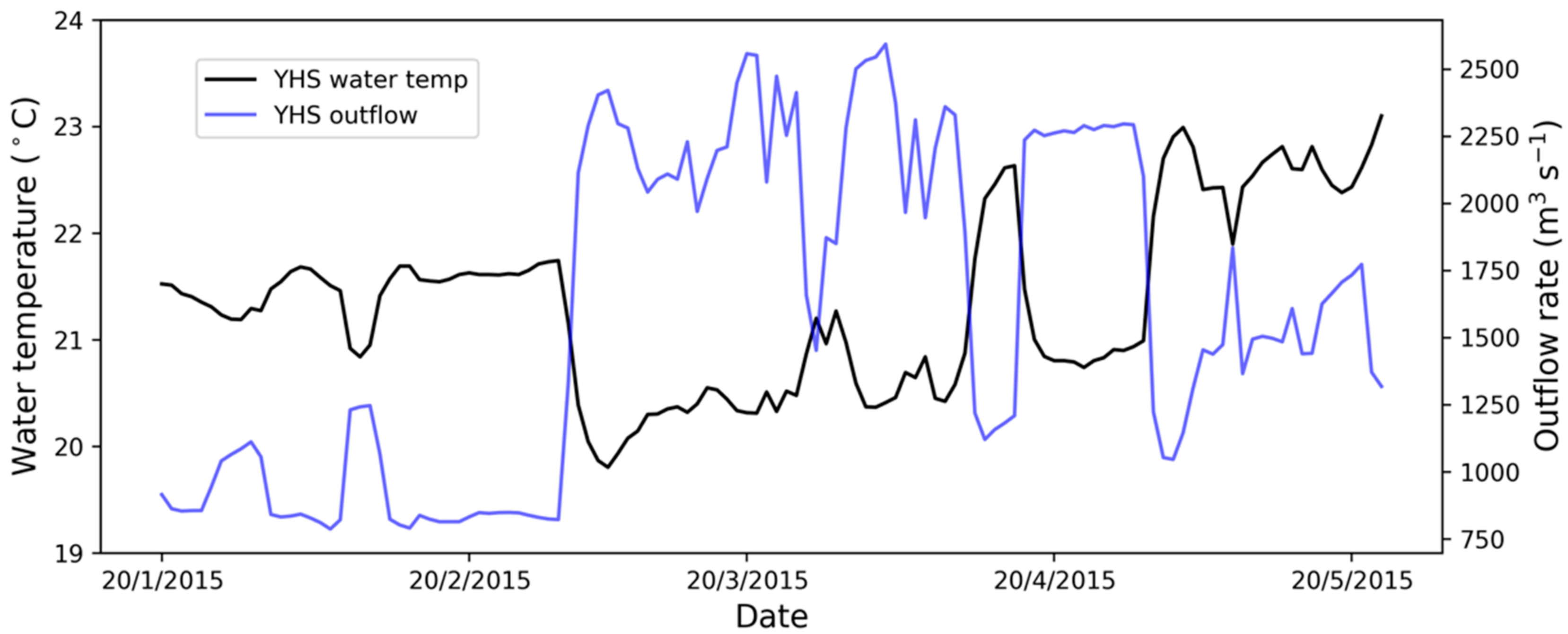


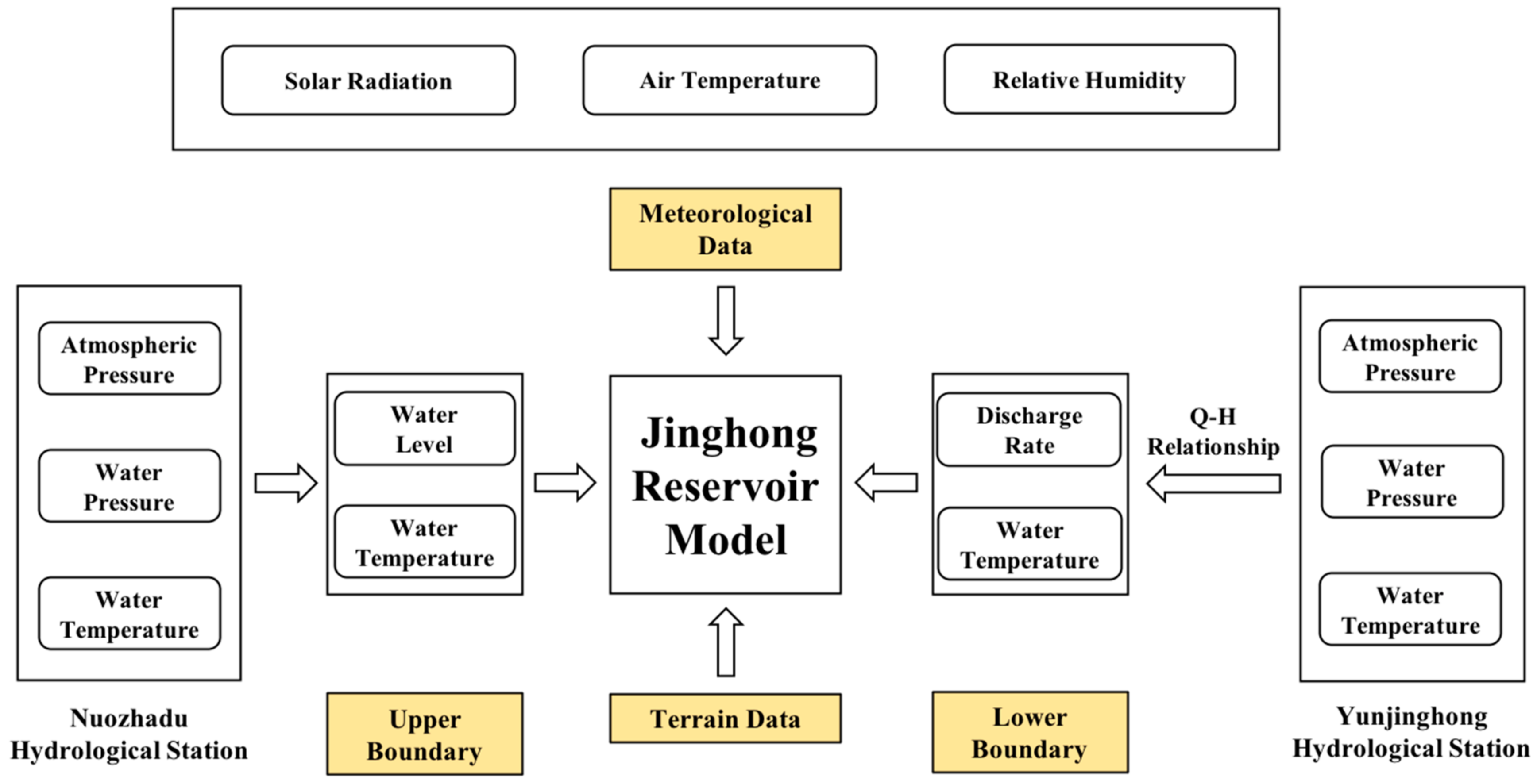
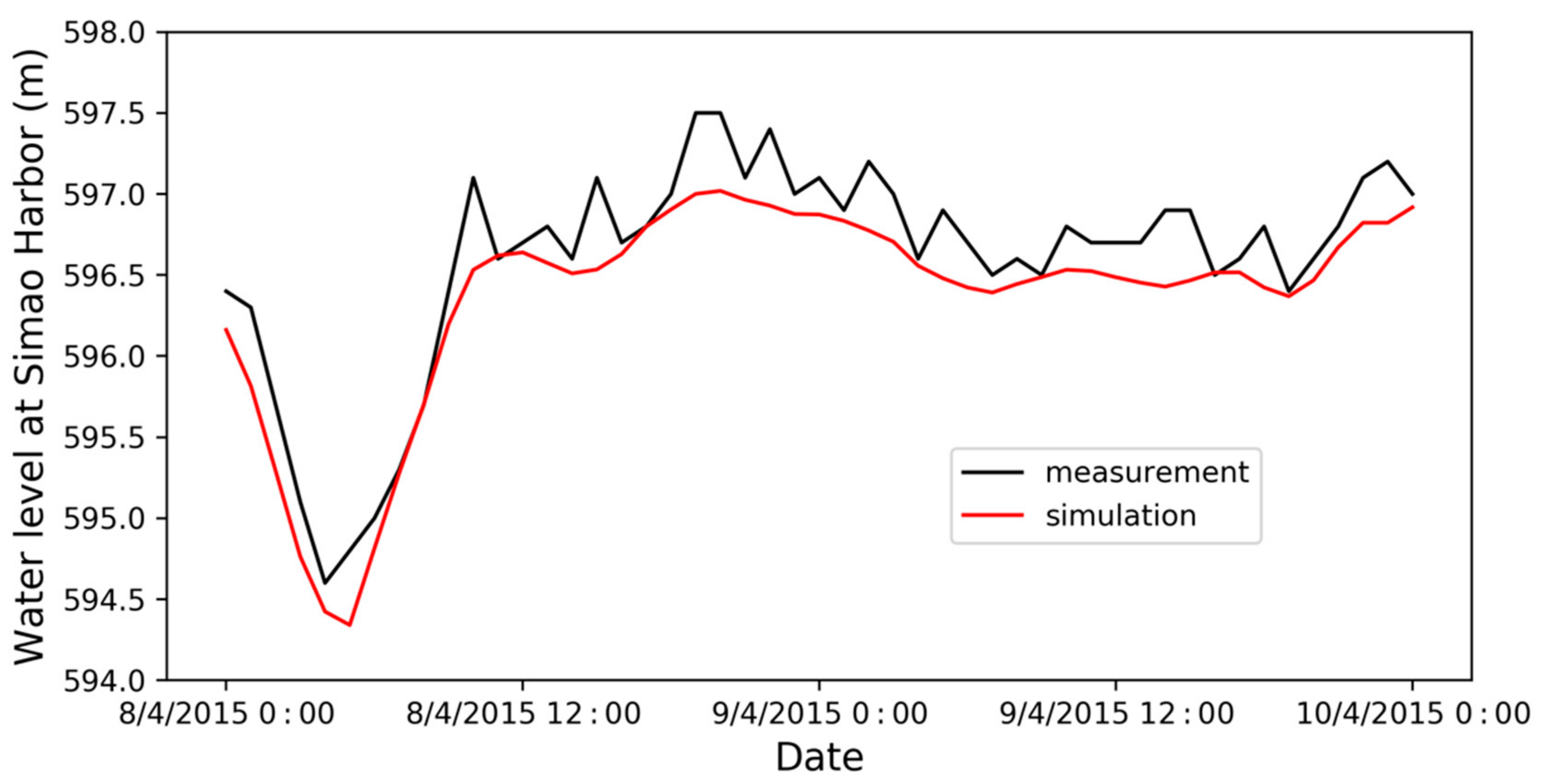
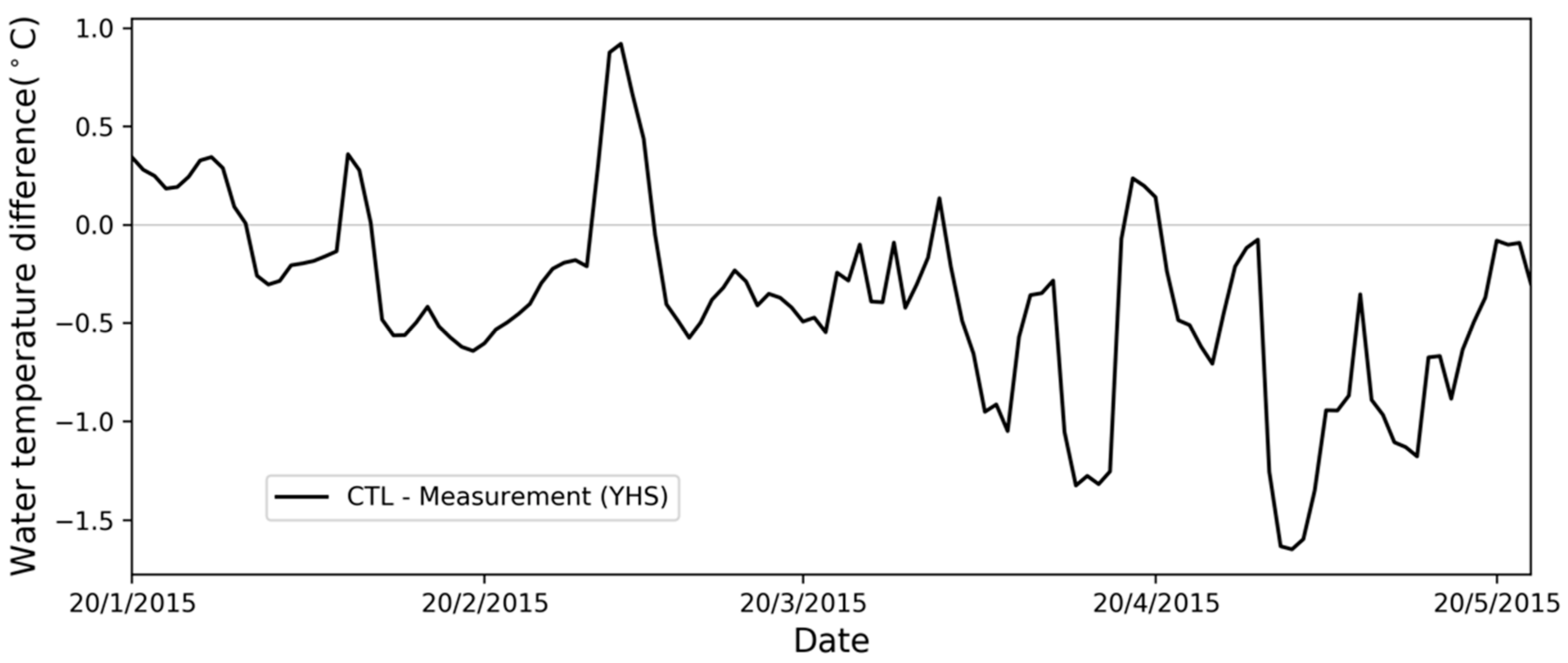
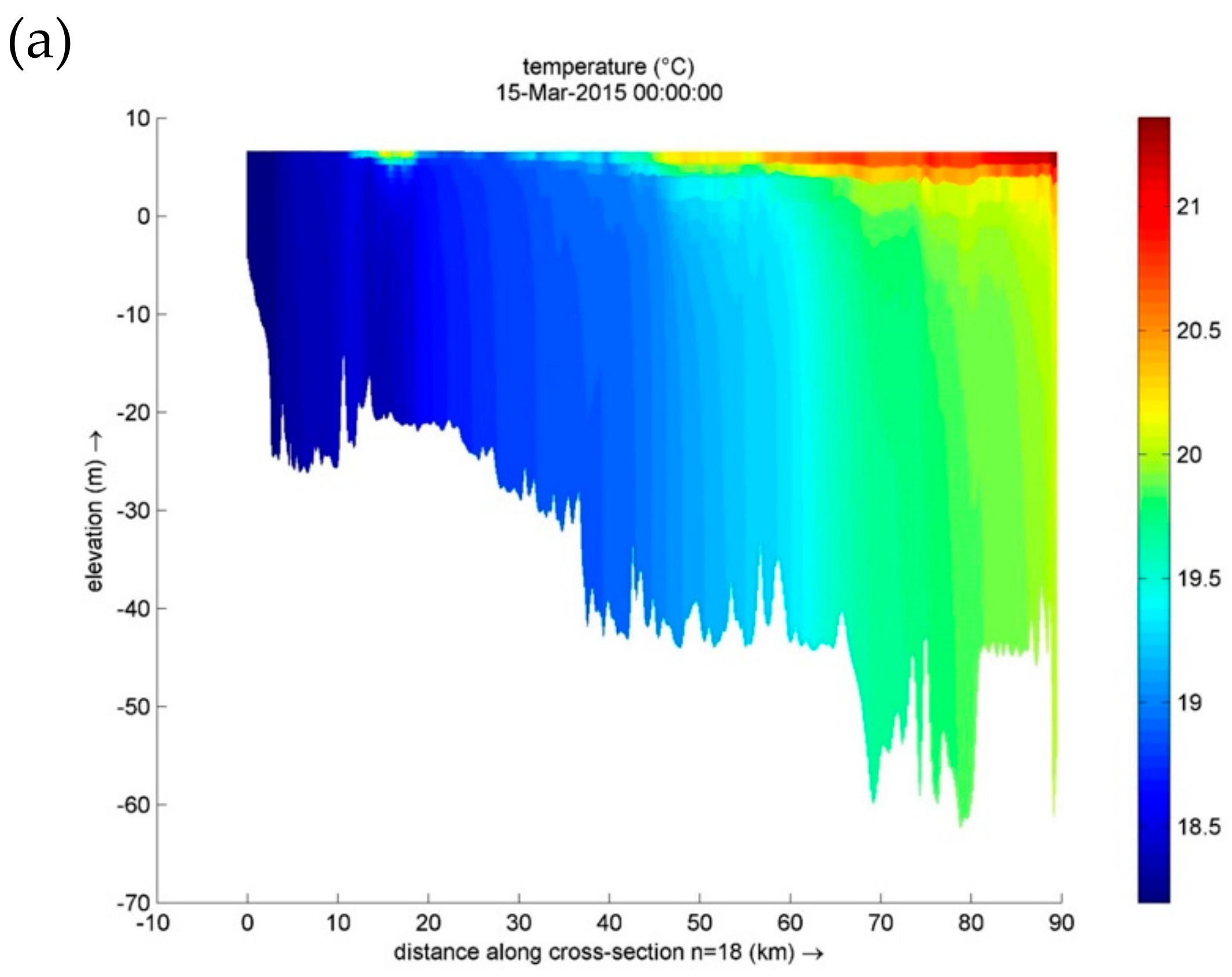
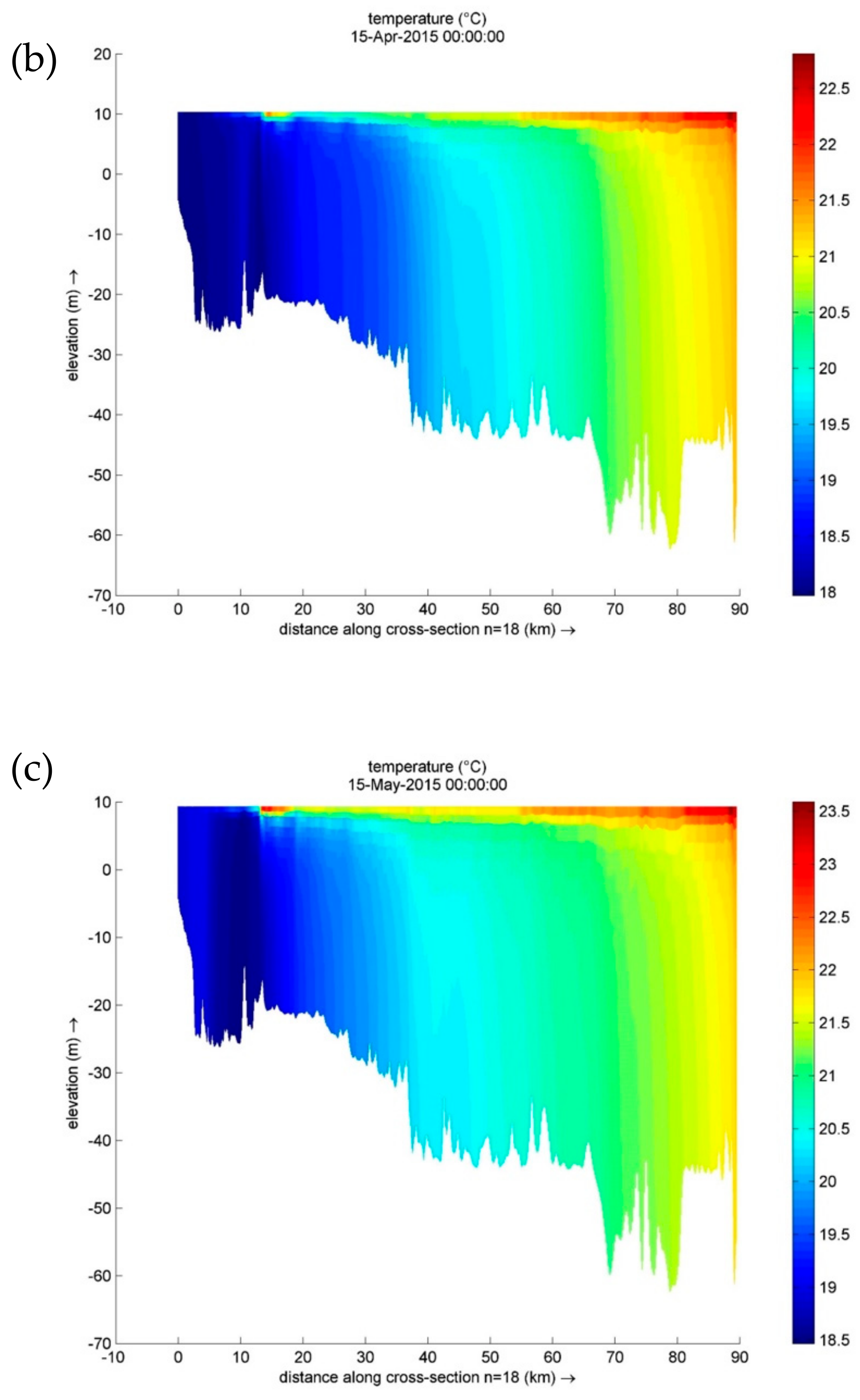


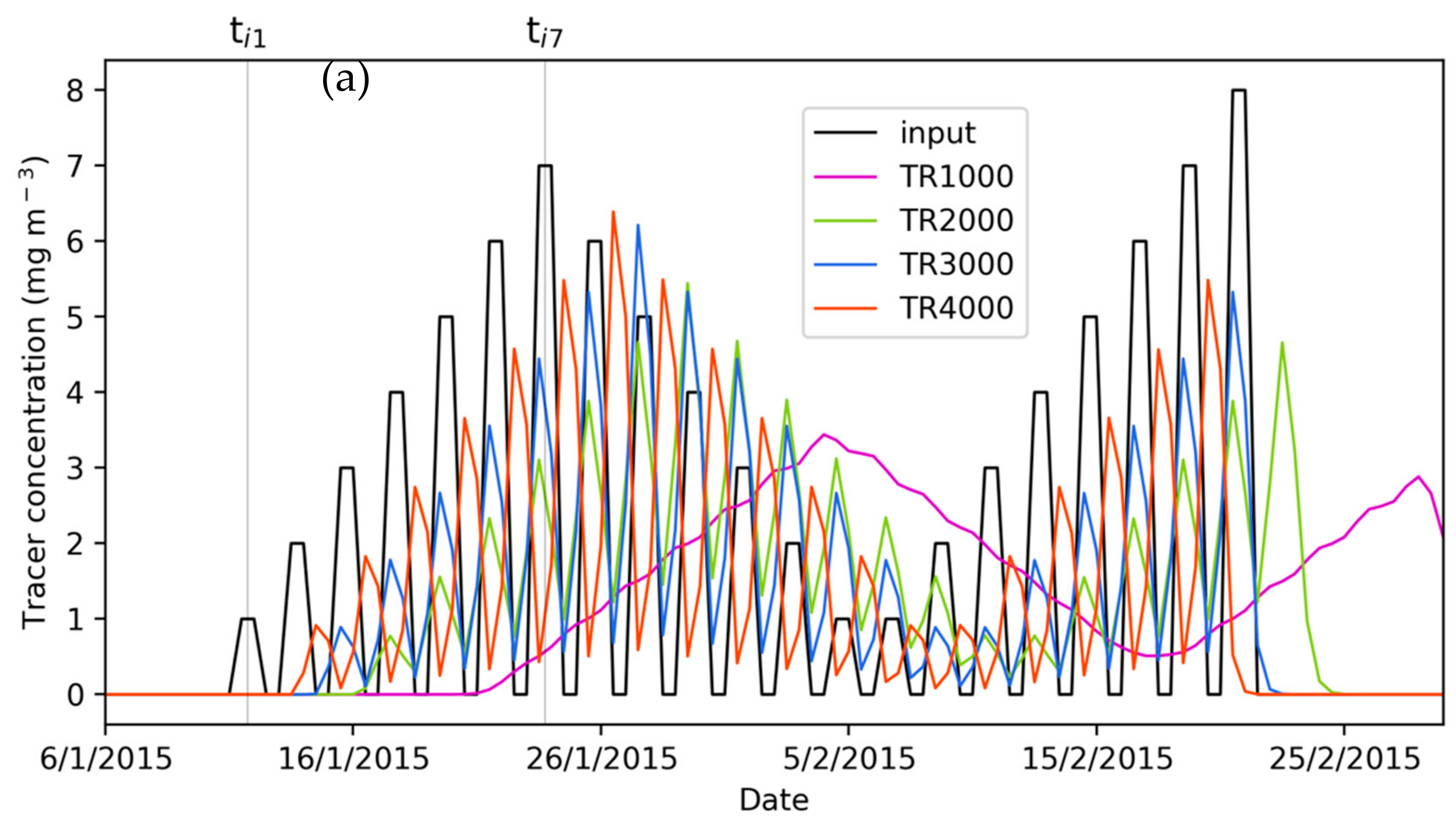
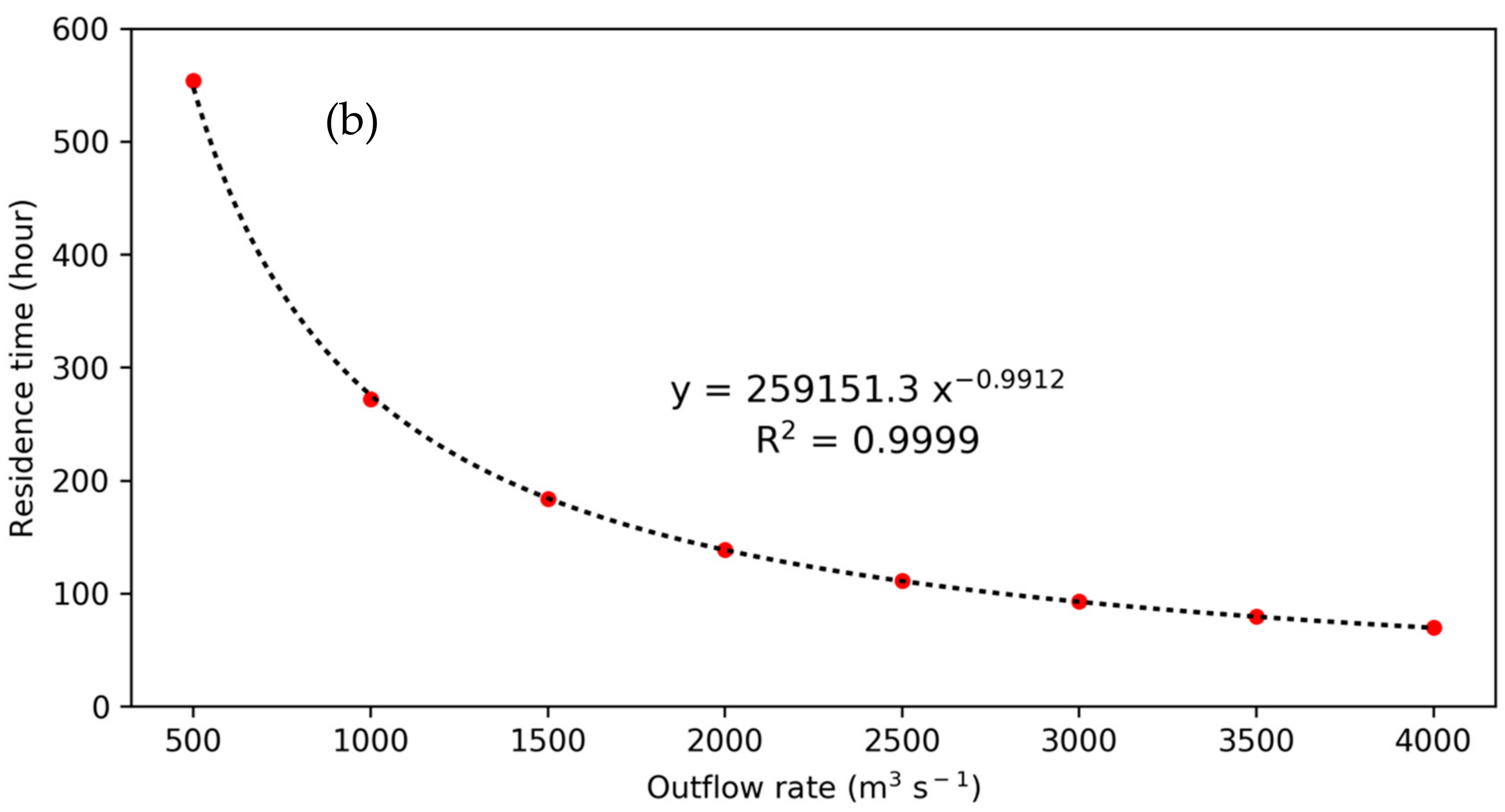
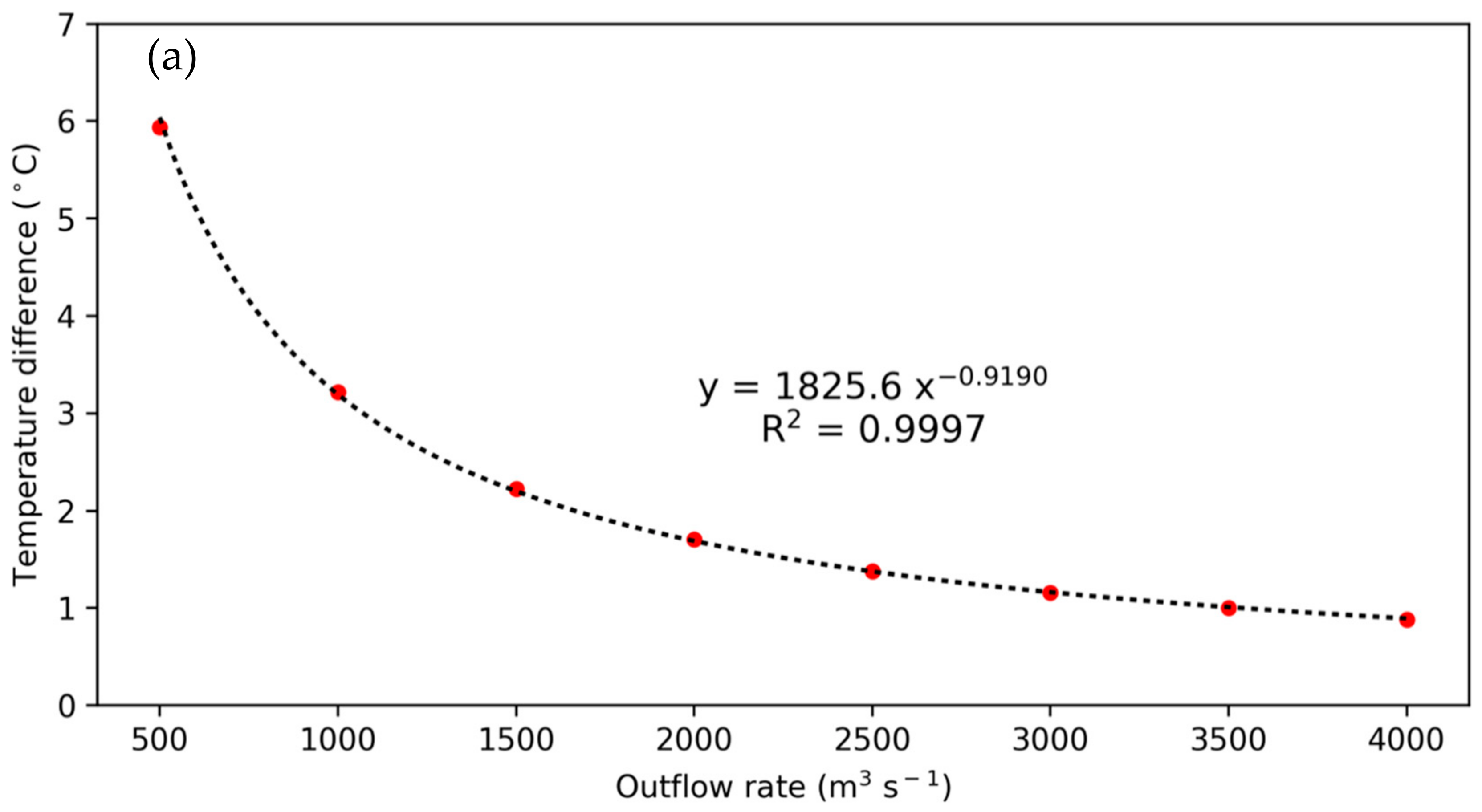
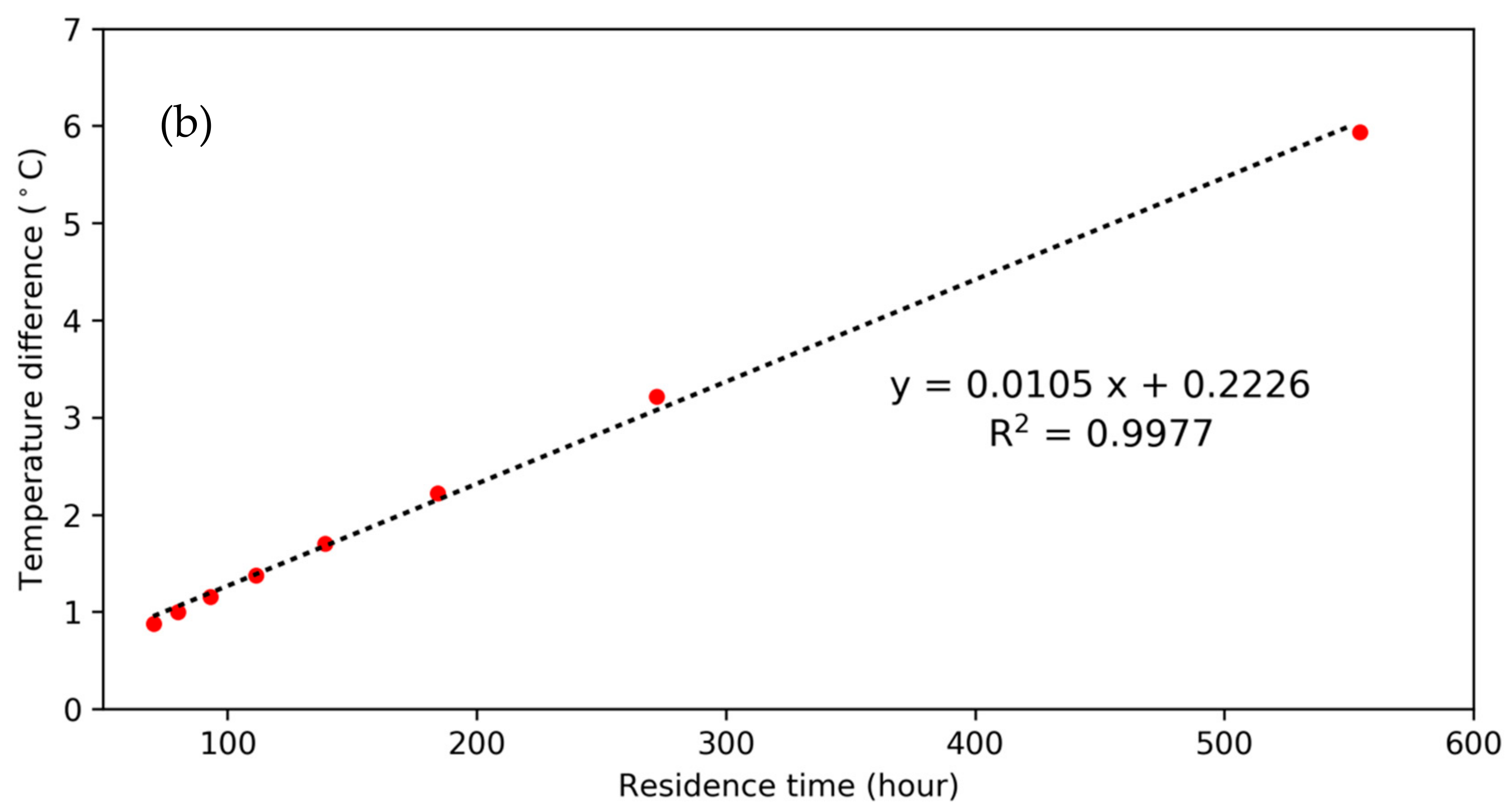
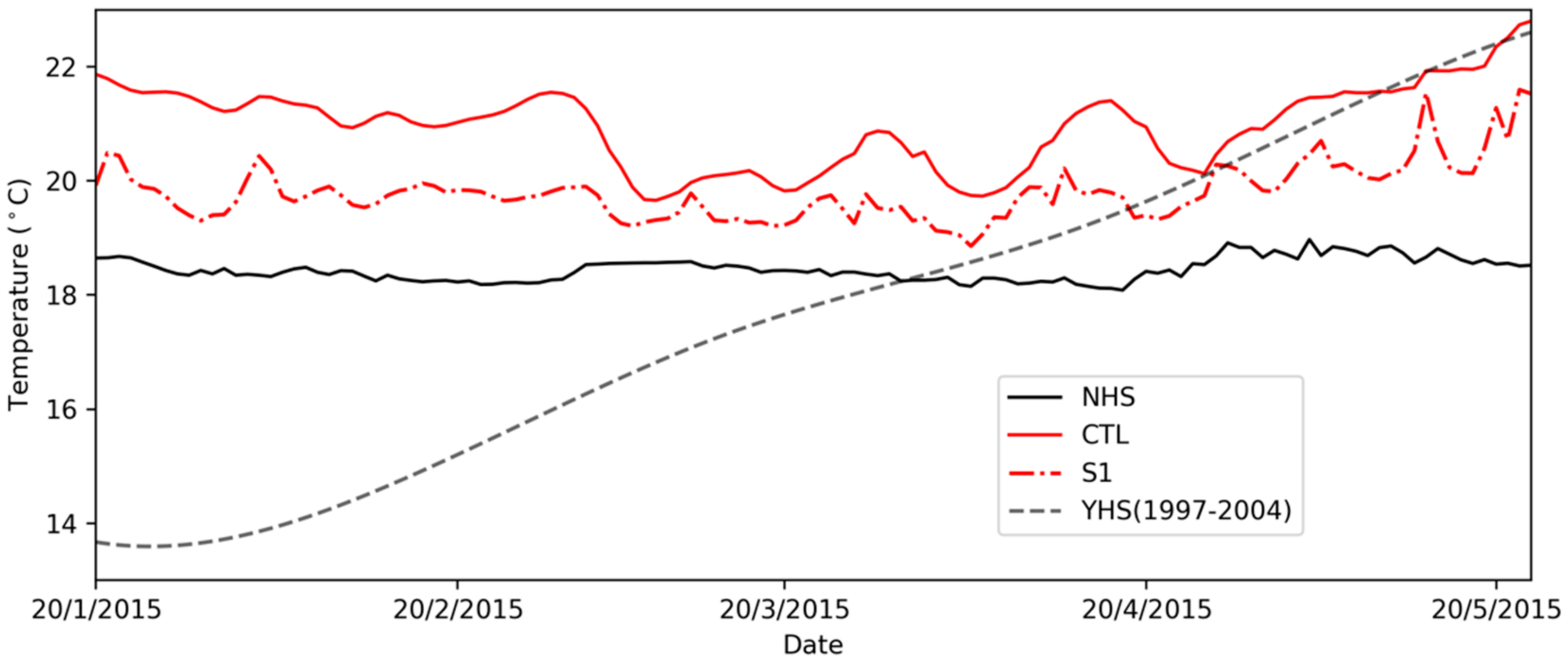
| Parameter | Studied Range | Chosen Value |
|---|---|---|
| Chezy’s coefficient | 10–100 m½ s−1 | 65 m½ s−1 |
| Background horizontal eddy viscosity | 1 × 10−6–1 m2 s−1 | 5 × 10−4 m2 s−1 |
| Background horizontal eddy diffusivity | 1 × 10−6–1 m2 s−1 | 1 × 10−4 m2 s−1 |
| Background vertical eddy viscosity | 1 × 10−10–1 m2 s−1 | 1 × 10−6 m2 s−1 |
| Background vertical eddy diffusivity | 1 × 10−10–1 m2 s−1 | 1 × 10−6 m2 s−1 |
| Experiments | The Jinghong Reservoir | Solar Radiation | Atmosphere-Water Heat Exchange | Outflow Rate (m3 s−1) | Tracer |
|---|---|---|---|---|---|
| CTL | ON | ON | ON | Real | OFF |
| S1 | OFF | ON | ON | Real | OFF |
| S2 | ON | OFF | ON | Real | OFF |
| S3 | ON | OFF | OFF | Real | OFF |
| F1 | ON | ON | ON | 500 | ON |
| F2 | ON | ON | ON | 1000 | ON |
| F3 | ON | ON | ON | 1500 | ON |
| F4 | ON | ON | ON | 2000 | ON |
| F5 | ON | ON | ON | 2500 | ON |
| F6 | ON | ON | ON | 3000 | ON |
| F7 | ON | ON | ON | 3500 | ON |
| F8 | ON | ON | ON | 4000 | ON |
| Reservoir Name | Average Annual Inflow (billion m3) | Total Capacity (billion m3) | α Index | Type |
|---|---|---|---|---|
| Xiaowan | 38.2 | 15.1 | 2.5 | Stably stratified |
| Nuozhadu | 55.5 | 23.7 | 2.3 | Stably stratified |
| Jinghong | 58.0 | 1.1 | 25.4 | Mixed |
© 2018 by the authors. Licensee MDPI, Basel, Switzerland. This article is an open access article distributed under the terms and conditions of the Creative Commons Attribution (CC BY) license (http://creativecommons.org/licenses/by/4.0/).
Share and Cite
Jiang, B.; Wang, F.; Ni, G. Heating Impact of a Tropical Reservoir on Downstream Water Temperature: A Case Study of the Jinghong Dam on the Lancang River. Water 2018, 10, 951. https://doi.org/10.3390/w10070951
Jiang B, Wang F, Ni G. Heating Impact of a Tropical Reservoir on Downstream Water Temperature: A Case Study of the Jinghong Dam on the Lancang River. Water. 2018; 10(7):951. https://doi.org/10.3390/w10070951
Chicago/Turabian StyleJiang, Bo, Fushan Wang, and Guangheng Ni. 2018. "Heating Impact of a Tropical Reservoir on Downstream Water Temperature: A Case Study of the Jinghong Dam on the Lancang River" Water 10, no. 7: 951. https://doi.org/10.3390/w10070951





